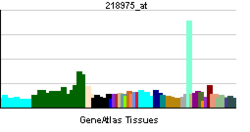Collagen, type V, alpha 3
Collagen alpha-3(V) chain is a protein that in humans is encoded by the COL5A3 gene.[3][4]
This gene encodes an alpha chain for one of the low abundance fibrillar collagens. Fibrillar collagen molecules are trimers that can be composed of one or more types of alpha chains. Type V collagen is found in tissues containing type I collagen and appears to regulate the assembly of heterotypic fibers composed of both type I and type V collagen. This gene product is closely related to type XI collagen and it is possible that the collagen chains of types V and XI constitute a single collagen type with tissue-specific chain combinations. Mutations in this gene are thought to be responsible for the symptoms of a subset of patients with Ehlers-Danlos syndrome type III. Messages of several sizes can be detected in northern blots but sequence information cannot confirm the identity of the shorter messages.[4]
References
Further reading
- van der Rest M, Garrone R (1991). "Collagen family of proteins". FASEB J. 5 (13): 2814–23. PMID 1916105.
- Fichard A, Kleman JP, Ruggiero F (1996). "Another look at collagen V and XI molecules". Matrix Biol. 14 (7): 515–31. doi:10.1016/S0945-053X(05)80001-0. PMID 8535602.
- Mann K (1992). "Isolation of the alpha 3-chain of human type V collagen and characterization by partial sequencing". Biol. Chem. Hoppe-Seyler. 373 (2): 69–75. doi:10.1515/bchm3.1992.373.1.69. PMID 1571108.
- Niyibizi C, Fietzek PP, van der Rest M (1984). "Human placenta type V collagens. Evidence for the existence of an alpha 1(V) alpha 2(V) alpha 3(V) collagen molecule". J. Biol. Chem. 259 (22): 14170–4. PMID 6501291.
- Abedin MZ, Ayad S, Weiss JB (1982). "Isolation and native characterization of cysteine-rich collagens from bovine placental tissues and uterus and their relationship to types IV and V collagens". Biosci. Rep. 2 (7): 493–502. doi:10.1007/BF01115247. PMID 7115902.
- Rhodes RK, Miller EJ (1982). "Evidence for the existence of an alpha 1(V) alpha 2(V) alpha 3(V) collagen molecule in human placental tissue". Coll. Relat. Res. 1 (4): 337–43. PMID 7346227.
- Kypreos KE, Sonenshein GE (1998). "Basic fibroblast growth factor decreases type V/XI collagen expression in cultured bovine aortic smooth muscle cells". J. Cell. Biochem. 68 (2): 247–58. doi:10.1002/(SICI)1097-4644(19980201)68:2<247::AID-JCB11>3.0.CO;2-C. PMID 9443080.
- Chanut-Delalande H, Fichard A, Bernocco S, et al. (2001). "Control of heterotypic fibril formation by collagen V is determined by chain stoichiometry". J. Biol. Chem. 276 (26): 24352–9. doi:10.1074/jbc.M101182200. PMID 11423559.
- Gopalakrishnan B, Wang WM, Greenspan DS (2004). "Biosynthetic processing of the Pro-alpha1(V)Pro-alpha2(V)Pro-alpha3(V) procollagen heterotrimer". J. Biol. Chem. 279 (29): 30904–12. doi:10.1074/jbc.M402252200. PMID 15136578.
- Nagato H, Matsuo N, Sumiyoshi H, et al. (2004). "The transcription factor CCAAT-binding factor CBF/NF-Y and two repressors regulate the core promoter of the human pro-alpha3(V) collagen gene (COL5A3)". J. Biol. Chem. 279 (45): 46373–83. doi:10.1074/jbc.M406069200. PMID 15316020.

